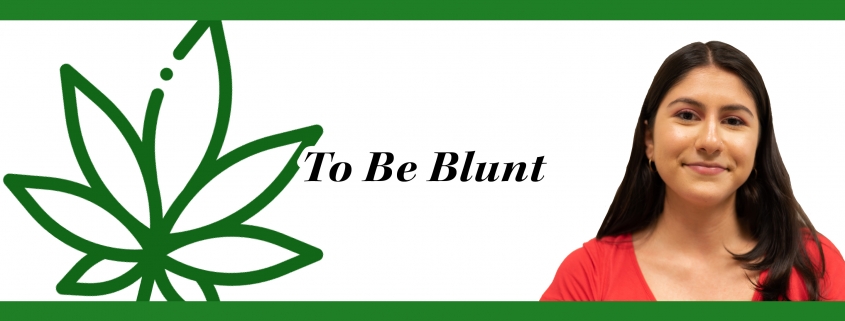To Be Blunt: Stoner slang shapes cannabis culture

Arguably nothing is as ubiquitous in stoner culture as 420. We giggle when the clock strikes 4:20 p.m. (or a.m.), and we try to catch a glimpse of the number on various screens — from our phones to our microwaves. Now, as we find ourselves in a monthlong 420 amid unprecedented times, it’s like we’re the punchline of one big cosmic joke. But what the fuck even is 420?
Although commonly mistaken as the penal code for cannabis use, 420’s origins trace back to the fall of 1971. A group of five high school stoners from Marin County in Northern California got word of a U.S. Coast Guard service member who could no longer tend to his cannabis plants. The group, nicknamed the Waldos, would meet at a statue of Louis Pasteur at San Rafael High at 4:20 p.m. after sports practice, get high and resume their quest for the hidden treasure. The code for meeting up? “4:20-Louis.” But “Louis” was eventually dropped. Although the Waldos never encountered the coveted cannabis plot after weeks of searching, their slang permeated the country as Marin County quickly became the epicenter of the counterculture movement of the ’60s.
Inadvertently, 420 became a popular culture phenomenon — one that is still relevant today. Slang surrounding weed and its consumption was born out of secrecy, a way to disguise criminal activity from any points of authority: teachers, parents, law enforcement. If no one understands what you’re actually talking about, it can’t really be held against you, right?
So what do we talk about when we talk about weed? With criminalization and prohibition, cannabis subculture — and the language around it — flourished. Weed culture, considered subversive and anti-establishment, cloaked itself under rich, creative linguistics. Cannabis wasn’t simply a product, it was a cultural staple.
Slang is just one of the many facets of a subculture that indicates belonging and community. A form of in-group signaling, when two people communicate through the same slang, they demonstrate a shared set of interests. As cannabis slang quickly spread beyond its local origins, it adapted just as rapidly so as to avoid detection by government officials. New words were implanted into the subculture to remain subversive and mask criminality.
Cannabis slang can be put into six categories, including words that reference the effects of the strain (giggle weed), its appearance (grass) and deceptive code words (gas). Hundreds of phrases we use today date back to much earlier than we think. Slang commonly believed to trace back to the 1960s actually has origins in the 1930s. Terms such as cannabis and ganja have existed for centuries and have historically been used to describe the medicinal qualities of the plant.
At the same time, slang evolved rapidly over the decades, with hyperlocal terminology dominating by the 1970s as hippie culture grew. But now, with legalization and decriminalization efforts cropping up, the way we talk about cannabis has shifted yet again.
Society has largely graduated from the illicit trading of cash for dime bags and the necessity of cannabis code words to glass counters at lux dispensaries and open, public conversation about one’s latest trip. What was once sketchy and criminal (of course, not if you’re white though!) is now the new hype — crisply pre-packaged, mechanically pre-rolled, expertly marketed and tied up in a neat, nice bow for the consumer.
As with everything, capitalism has taken a huge shit on cannabis. The commodification of weed has stripped cannabis of its cultural iconicity. Legalization has unwittingly brought with it consumerism and, ultimately, the immense loss of community. We have to face it: Weed has been gentrified.
Nothing points this out as clearly as the names of myriad popularized dispensaries. With vague, clinical names, weed shops reflect the exact opposite of cannabis’ rich history of vibrant jargon. The dreaded gentrified MedMen (also known as the Apple Store of weed shops) just sounds like a bad Netflix Original, while places such as New Age Care Center bring forth images of retirement homes or hubs where pseudoscience reigns supreme. Arguably, we have lost what makes weed, weed.
Businesses don’t want to call it pot or chronic or loud or anything else informal. In the struggle to establish themselves as serious capital ventures, dispensaries stick to just calling it cannabis or, even worse, marijuana. While I can’t really blame them, as the mainstream public and government officials still see weed as a nuisance indicative of delinquent behavior, I can’t say it’s my cup of tea. Slowly, but surely, cannabis is becoming everything weed smokers were historically against.
We are trending toward a reality where cannabis is just another product — one to be advertised, sold and consumed (not that there’s anything wrong with the lattermost). I’m not saying that we should revert to prohibition; I’m just asking for a gram of culture, a nug of enjoyment. While terms denoting wellness or care may highlight pot’s medicinal qualities, they are — quite frankly — bland.
But cannabis culture is pervasive and intrinsically adaptive — stoners aren’t going anywhere. Creative dispensary names, such as The Pottery, Smokey’s 420 House and Bud Hut, remain. And as always, slang adapts and evades extinction. From mid to presh, chop to the Devil’s lettuce, hyperlocal and mainstream jargon persists. People stay baked, blazed, zooted, faded and sauteed (not really sure if the last one exists outside my friend group, but I would like to see it become a thing).
While I’m glad cannabis is losing its stigma, it’s also clear we’re losing much more. We’ve moved on from clandestine transactions that sparked rich enclaves and language adaptations to socioculturally insignificant (yet, I admit, convenient) weed delivery services. Perhaps that one British television show was right: The secret ingredient is crime.
Natalie Oganesyan is a junior writing about weed culture and politics. She is also an associate managing editor at the Daily Trojan. Her column, “To Be Blunt,” typically runs every other Friday.

